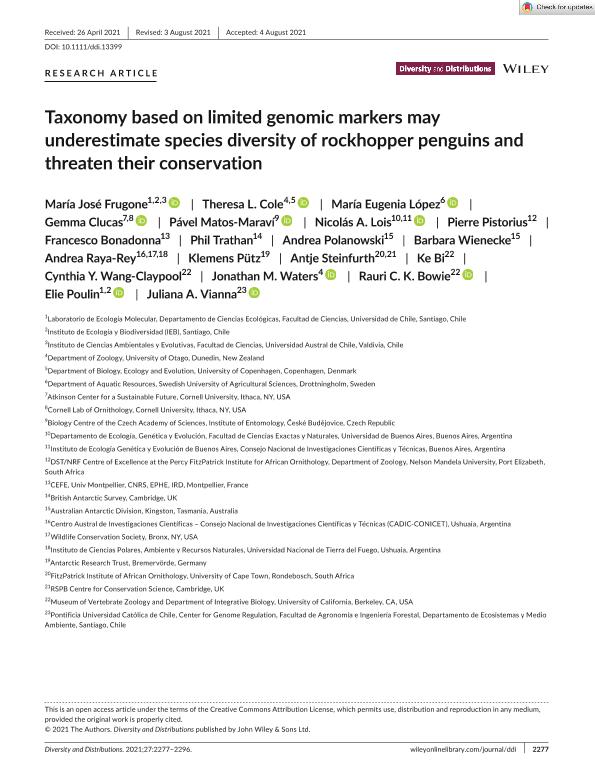Artículo
Taxonomy based on limited genomic markers may underestimate species diversity of rockhopper penguins and threaten their conservation
Frugone, María José; Cole, Theresa L.; López, María Eugenia; Clucas, Gemma; Matos Maraví, Pável; Lois, Nicolás Alejandro ; Pistorius, Pierre; Bonadonna, Francesco; Trathan, Phil; Polanowski, Andrea; Wienecke, Barbara; Raya Rey, Andrea Nélida
; Pistorius, Pierre; Bonadonna, Francesco; Trathan, Phil; Polanowski, Andrea; Wienecke, Barbara; Raya Rey, Andrea Nélida ; Pütz, Klemens; Steinfurth, Antje; Bi, Ke; Wang Claypool, Cynthia Y.; Waters, Jonathan M.; Bowie, Rauri C. K.; Poulin, Elie; Vianna, Juliana A.
; Pütz, Klemens; Steinfurth, Antje; Bi, Ke; Wang Claypool, Cynthia Y.; Waters, Jonathan M.; Bowie, Rauri C. K.; Poulin, Elie; Vianna, Juliana A.
 ; Pistorius, Pierre; Bonadonna, Francesco; Trathan, Phil; Polanowski, Andrea; Wienecke, Barbara; Raya Rey, Andrea Nélida
; Pistorius, Pierre; Bonadonna, Francesco; Trathan, Phil; Polanowski, Andrea; Wienecke, Barbara; Raya Rey, Andrea Nélida ; Pütz, Klemens; Steinfurth, Antje; Bi, Ke; Wang Claypool, Cynthia Y.; Waters, Jonathan M.; Bowie, Rauri C. K.; Poulin, Elie; Vianna, Juliana A.
; Pütz, Klemens; Steinfurth, Antje; Bi, Ke; Wang Claypool, Cynthia Y.; Waters, Jonathan M.; Bowie, Rauri C. K.; Poulin, Elie; Vianna, Juliana A.
Fecha de publicación:
11/2021
Editorial:
Wiley Blackwell Publishing, Inc
Revista:
Diversity and Distributions
ISSN:
1366-9516
Idioma:
Inglés
Tipo de recurso:
Artículo publicado
Clasificación temática:
Resumen
Aim: Delimiting recently diverged species is challenging. During speciation, genetic differentiation may be distributed unevenly across the genome, as different genomic regions can be subject to different selective pressures and evolutionary histories. Reliance on limited numbers of genetic markers that may be underpowered can make species delimitation even more challenging, potentially resulting in taxonomic inconsistencies. Rockhopper penguins of the genus Eudyptes comprise three broadly recognized taxa: northern (E. moseleyi), southern (E. chrysocome) and eastern rockhopper (E. filholi). Their taxonomic status has been controversial for decades, with researchers disagreeing about whether E. chrysocome and E. filholi are distinct species or conspecific. Our goal is to evaluate genome-wide patterns of divergence to evaluate genetic differentiation and species delimitation in rockhopper penguins, and to assess which mechanisms may underlie previous discordance among nuclear versus mitochondrial analyses. Location: Sub-Antarctic and temperate coastal regions of the Southern Hemisphere. Methods: We generated reduced-representation genomic libraries using double digest restriction-site associated DNA (ddRAD) sequencing to evaluate genetic differentiation, contemporary migration rates and admixture among colonies of rockhopper penguins. Results: The extent of genetic differentiation among the three taxa was consistently higher than population-level genetic differentiation found within these and other penguin species. There was no evidence of admixture among the three taxa, suggesting the absence of ongoing gene flow among them. Species delimitation analyses based on molecular data, along with other lines of evidence, provide strong support for the taxonomic distinction of three species of rockhopper penguins. Main conclusions: Our results provide strong support for the existence of three distinct species of rockhopper penguins. The recognition of this taxonomic diversity is crucial for the management and conservation of this widely distributed species group. This study illustrates that widespread dispersive seabird lineages lacking obvious morphological differences may nevertheless have complex evolutionary histories and comprise cryptic species diversity.
Palabras clave:
EUDYPTES
,
GENOMICS
,
ROCKHOPPER PENGUINS
,
SPECIES DELIMITATION
Archivos asociados
Licencia
Identificadores
Colecciones
Articulos(CADIC)
Articulos de CENTRO AUSTRAL DE INVESTIGACIONES CIENTIFICAS
Articulos de CENTRO AUSTRAL DE INVESTIGACIONES CIENTIFICAS
Articulos(IEGEBA)
Articulos de INSTITUTO DE ECOLOGIA, GENETICA Y EVOLUCION DE BS. AS
Articulos de INSTITUTO DE ECOLOGIA, GENETICA Y EVOLUCION DE BS. AS
Citación
Frugone, María José; Cole, Theresa L.; López, María Eugenia; Clucas, Gemma; Matos Maraví, Pável; et al.; Taxonomy based on limited genomic markers may underestimate species diversity of rockhopper penguins and threaten their conservation; Wiley Blackwell Publishing, Inc; Diversity and Distributions; 27; 11; 11-2021; 2277-2296
Compartir
Altmétricas



